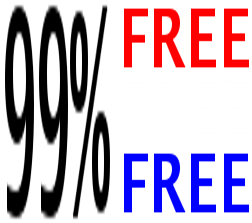
Freemium: 99 procent free
A few days ago Fast Company published a story about ‘Evernote CEO Phil Libin’s 3 Steps to “Freemium” Success‘, which he achieved with his company and service Evernote. The Freemium business model is based on providing free basic services and earning money from users opting to pay for additional features. The competitive advantage is in price. A free product cannot be beaten (on price) by an even cheaper product. The article presents 3 success factors and from the text a few preconditions can be distilled:
- A massive potential audience
- A big wallet: setting up a Freemium service and reaching a critical mass user base requires big investments
- Next-to-nothing operating costs: extra users should hardly add extra costs to serve
- A gotta-have-it value to consumers and the product should invite ‘word of mouth’
- A high user retention rate: once customers start use the service, they will keep using it
- Regularly introduce new services, some free, some only available to paying customers
How are others doing
I thought it would be interesting to score some Freemium service providers on the preconditions.
| Service name | Skype | Spotify |
|
| Product | Voice over IP | Music streaming | Professional networking |
| Paying users get | Unlimited or cheap calls to offline phone numbers | Higher sound quality, no 20 hour limit per month, no adds | Be more visible to job offering companies, Profile Organizer |
| Preconditions | |||
| Massive potential audience | Yes | Yes | Yes |
| Critical mass | Yes | Yes, or not yet | Yes |
| Next-to-nothing operating costs | Expected | Expected | Expected |
| Gotta-have-it value | Not any more (only specific target audiences) | Yes | Yes |
| Word of mouth | Yes | Yes | Yes |
| High user retention rate | No, no strong community, easy to move to alternative provider for paid services | Might be easy to move to alternative provider if community sense is not strong | Yes |
| Regularly introduces new free and paid services | No, only new countries | Unknown | Yes |
The assessment above requires some explanation as it is partially based on my personal experience.
From the overview above, one could conclude that Skype is in for a rough ride. Skype has been there for quite some years. Although Skype user numbers seem to be still increasing (but slower than before), at least in my personal network, usage seems to become less frequent. In my view, in stead of a universal communication tool, it seems to slowly become a tool that people start when they want to have a cheap call. Not something they use all the time. The paid services of Skype seem to be easily replaceable by a cheaper service. The user retention rate therefore seems low. LinkedIn distinguishes itself from Skype in that sense: you don’t take your profile offline when you are not seeking a new business opportunity for a while. And if all your friends and colleagues are on LinkedIn, it makes sense to stay there as well.
Spotify is fast growing at the moment with it’s Spotify Open service and we shall see if they can reach the necessary critical mass. It will be interesting to see how they keep their user retention rate up and prevent users to start listening via a competitor service.
Success factors
According to Phil Libin success in Fremium business can be guaranteed when you (from the original article):
- Win millions of free users
- Convert more active users to premium status over time
- Keep costs down
Especially the first factor is not easy to achieve. The business model alone will not guarantee success. In the end it’s the product that counts. As Phil Libin put’s it: “I didn’t want a clever business model. [] I wanted a clever product. I wanted that product to reach hundreds of millions of people. And I wanted 99% of them to be using it for free.”
For a comparison of the Freemium business model and the low sales complexity, have a look at How Sales Complexity impacts your Startup’s Viability.
Other examples of Freemium services are: Plaxo, Filesanywhere and dropbox. Other case studies can be found here.